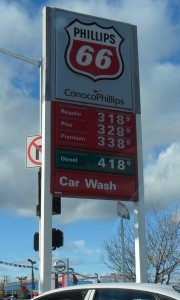In eastern Idaho, the difference between the price of one gallon of regular gasoline, versus diesel, is now a full one dollar.
On November 19, the average price, in the Pocatello/Chubbuck area, hit $3.18 per gallon for regular gasoline, and $4.18 for diesel.
The U.S. Energy Information Administration (USEIA) says gas prices are falling, in general, due to the usual seasonal drop in usage. I’ve never seen it drop by this much, here in eastern Idaho. Back in May, the average price was $3.65 per gallon, and it stayed that way through most of the summer. In the past two or three months the price has dropped almost 60 cents.
The USEIA also says regional fuel refining has a lot to do with prices, but back in September I discovered that PADD 4 gasoline production was being kept below demand. The latest data on PADD 4 gas production shows that, after months of keeping it around 290 thousand barrels per day, regional refineries are now pushing out more than 324 thousand barrels per day. This is why gas prices, in the Rocky Mountain area (PADD 4) are, or should be, dropping.
In California it’s a different story. The latest gasoline price survey shows the average price around $3.54 per gallon, with many areas paying $3.79. California taxes are one reason for the higher prices, but the other reason is that California refines its own fuel, and the refineries are in trouble.
According to the USEIA, despite having the third largest refinery industry in the country California’s refineries are maxed out, there’s just too many people driving too many vehicles. The USEIA is warning of a fuel price catastrophe in California: “California refineries need to be running near full capacity to meet the State’s gasoline demand. If more than one of its refineries experiences operating problems at the same time, California’s gasoline supply may become very tight and prices can soar. Even when supplies can be obtained from some Gulf Coast and foreign refineries, they can take a relatively long time to arrive due to California’s substantial distance from those sources. The farther away the necessary relief supplies are, the higher and longer the price spike will be.”
Regarding the rising cost of diesel fuel, it looks like some of what I warned about back on November 5 is coming true. Bottom line; around the world diesel production is down, while international demand is going up and up.
The latest reports on diesel commodity prices show a slight decrease. The decrease is so small that the global increase in demand for diesel will still cause pump prices to go up.
And how does the global demand affect us here in the U.S.? According to the American Petroleum Institute (API), most diesel fuel produced in the Untied States is actually being exported to other countries (a 37.6% increase, in both diesel and gasoline exports, in the past year). That means less diesel for the domestic market.
Diesel fuel is part of the “distillates” family of fuels. In the U.S. ultra low sulfur diesel is referred to as “Distillate Fuel Oil 15 ppm (parts per million) and under of Sulfur”. According to USEIA records, ultra low sulfur production, in the United States, varies between 3.2 million and 3.6 million barrels per day. Now realize that international demand has gone up, and that U.S. refineries are exporting much of their diesel. Since overall production is remaining in the 3 million to 4 million barrels per day rang, that doesn’t leave much for us. The result is diesel prices will continue to go up, until U.S. distillate refiners greatly increase production.
For those of us in the Rocky Mountain (PADD 4) area, the USEIA shows an up and down pattern for “Distillate Fuel Oil 15 ppm (parts per million) and under of Sulfur”. From March through May, diesel production was stuck at about 160 thousand barrels per day. By the end of July it increased to 195 thousand barrels per day. Since the end of August it’s dropped, to 185 thousand. That explains why diesel pump prices in the Rocky Mountain area are going up.
But here’s one more reason, and one that many diesel fuel users have speculated on; the high pump prices of diesel is an attempt by producers to make a bigger profit, since they’ve actually been keeping gasoline pump prices artificially low. A Reuters article states just that: “This in turn crimps diesel output until the cost of the fuel gets high enough to offset losses from additional gasoline sales.”
The Reuters article explains, not very well, that ultra low sulfur refining requires hydrocracking, a process involving hydrogen. It’s also used for gasoline. The problem is that many refineries in the U.S. can not produce both diesel and gasoline. This might explain the swings in production; one month gasoline production up, and diesel down, the next month it’s reversed.
The push for fracking natural gas, is actually for the fuel refining industry, because it turns out that using the hydrogen in natural gas is a good cheap way to conduct hydrocracking in fuel refining.
Eventually more diesel will be produced, because of the global demand. Several companies in the Gulf Coast area have invested billions of dollars to build new refineries to extract the hydrogen from natural gas to hydrocrack new diesel fuel.
Diesel fuel users should really look into making their own biodiesel, even though you could get into trouble with the Federal and State tax collectors, as well as the EPA. Here’s some links: Backwoods Home Official BioDiesel Home BioDiesel Diesel Master JR Whipple (good for moonshine too, remember diesel is a distillate) There plenty more sites on the internet about making your own diesel, do the research.
